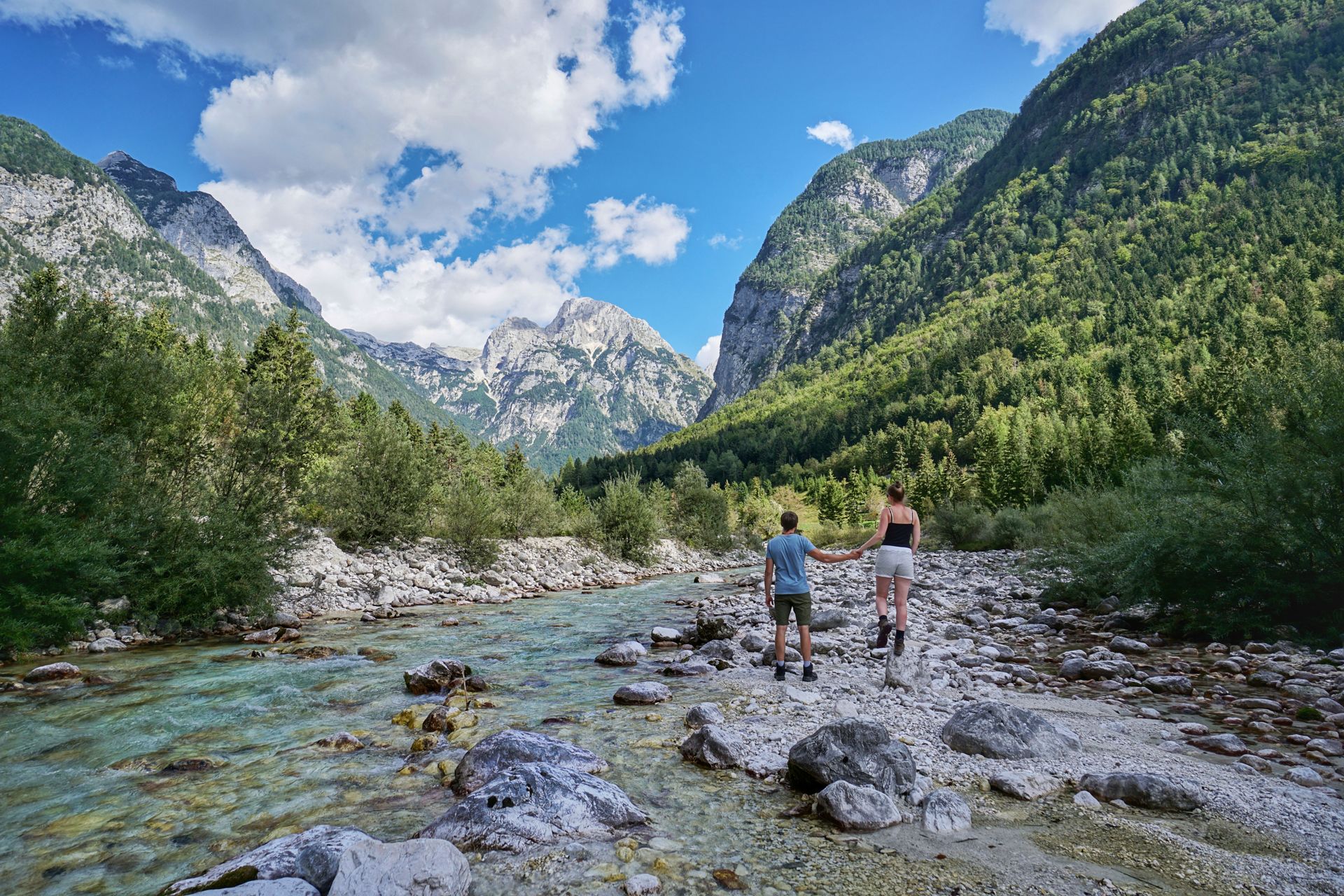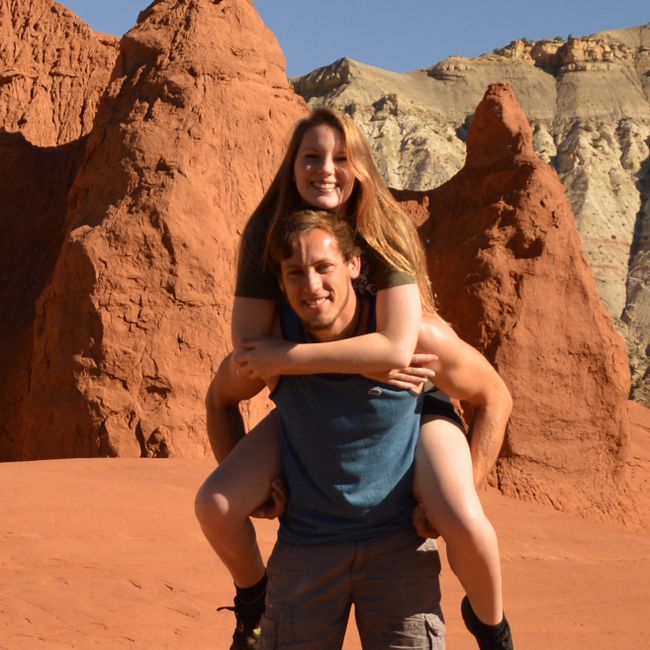7. Stop: Indonesia, Part 2: Java
Հրատարակվել է: 26.07.2019
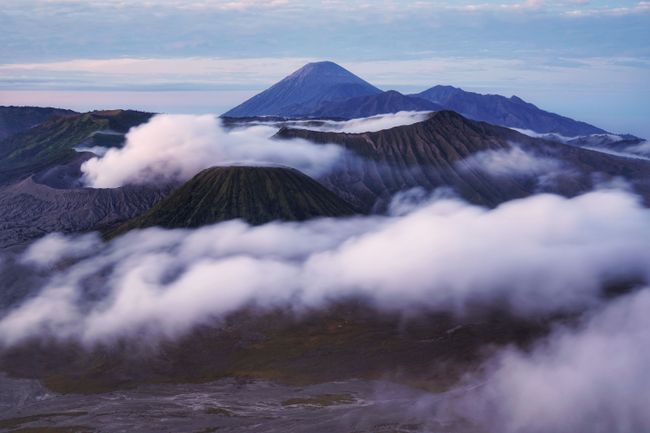
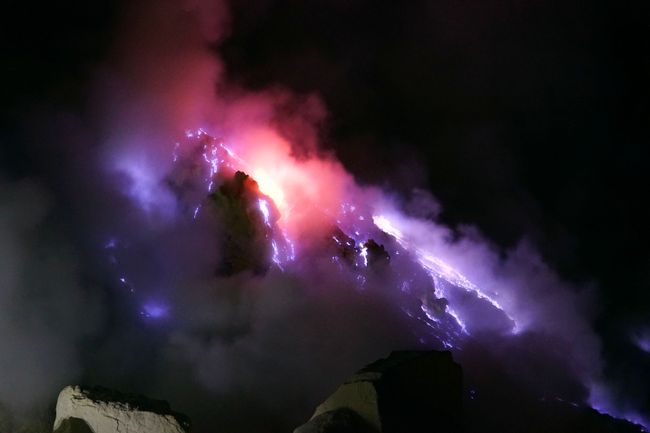
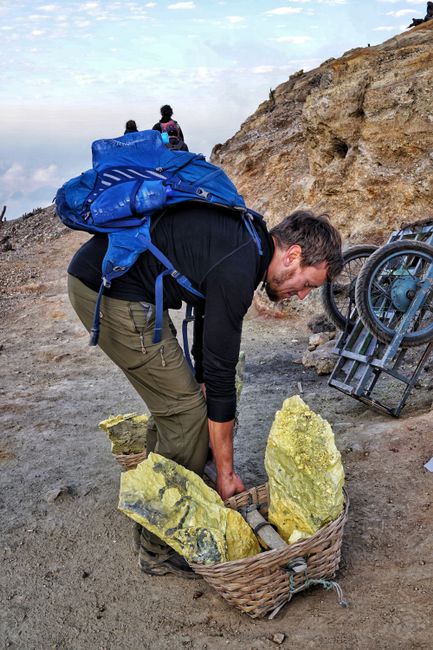
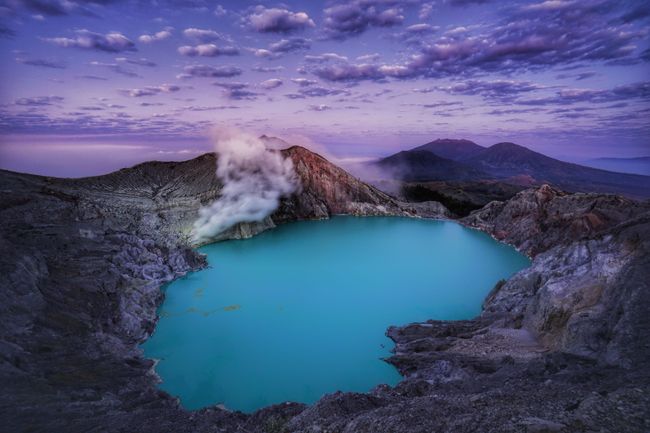
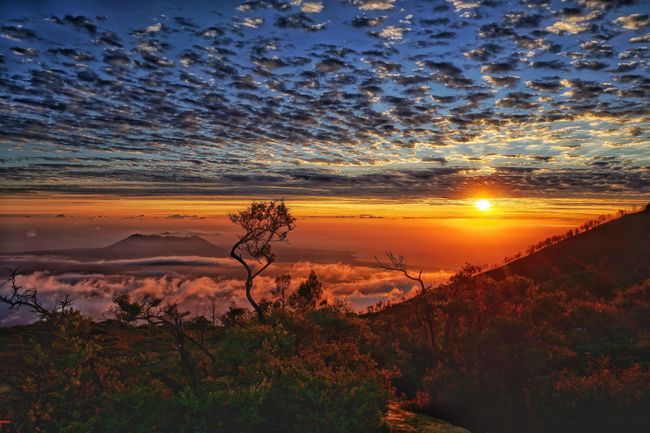
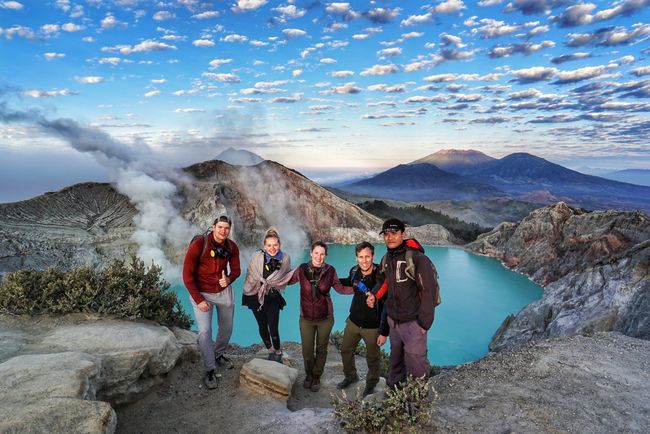
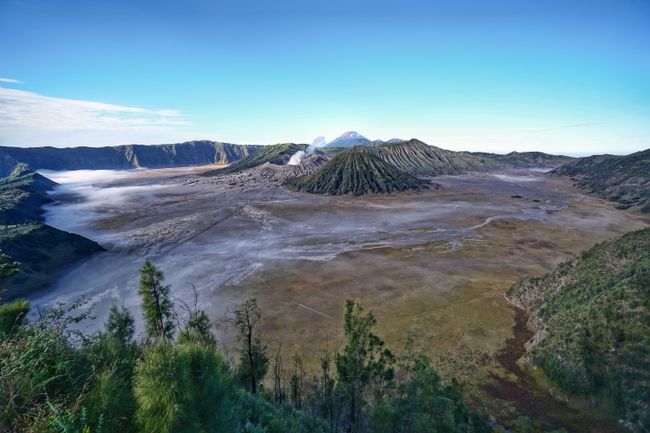
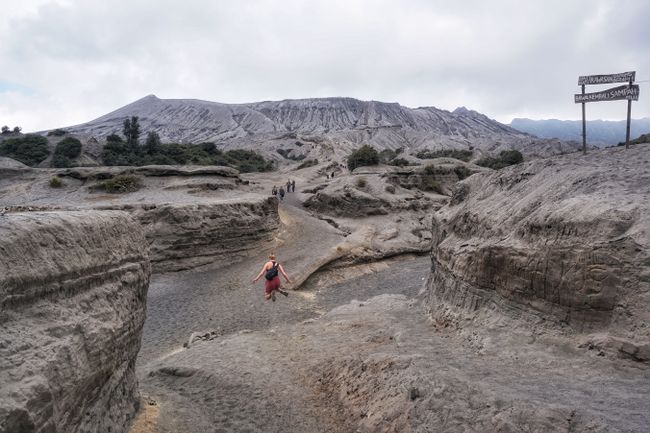
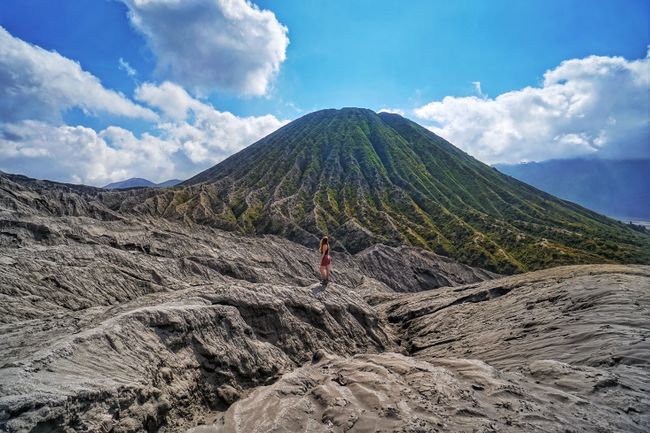
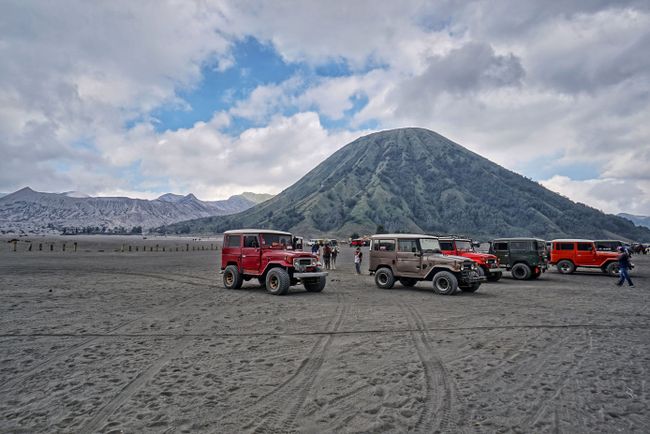
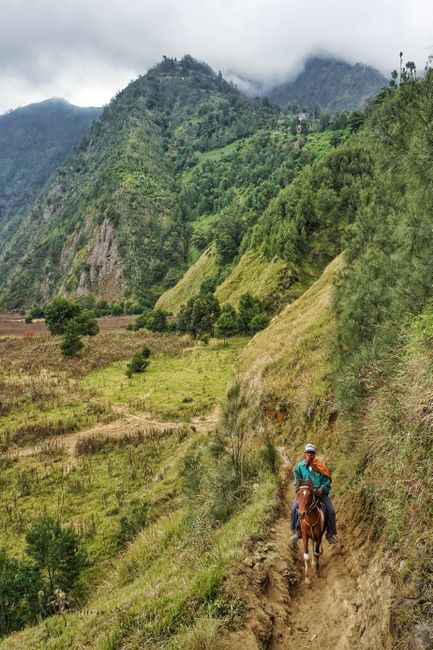
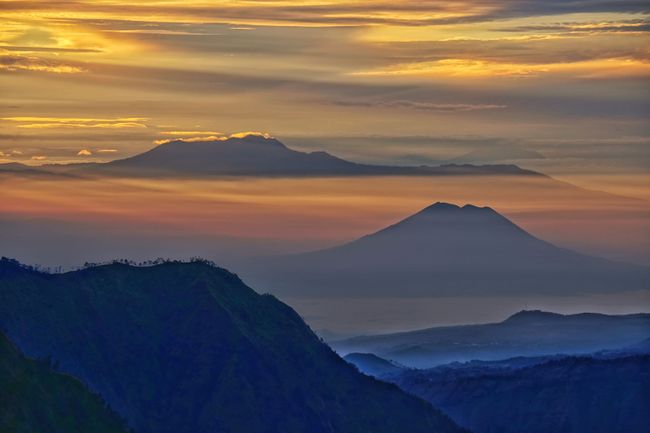
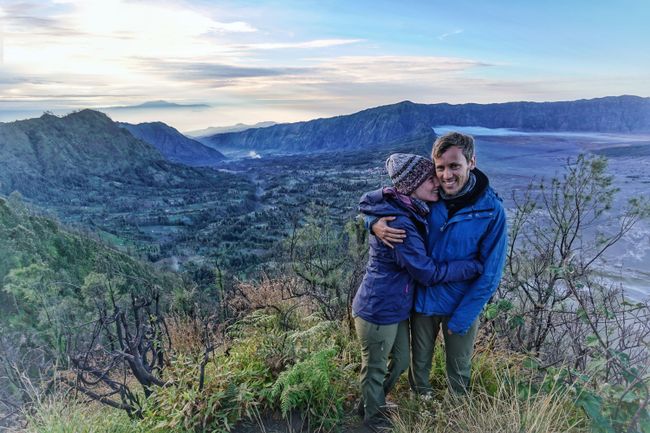
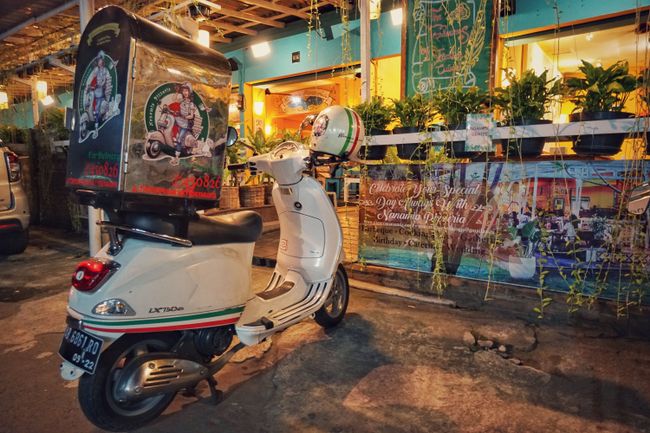
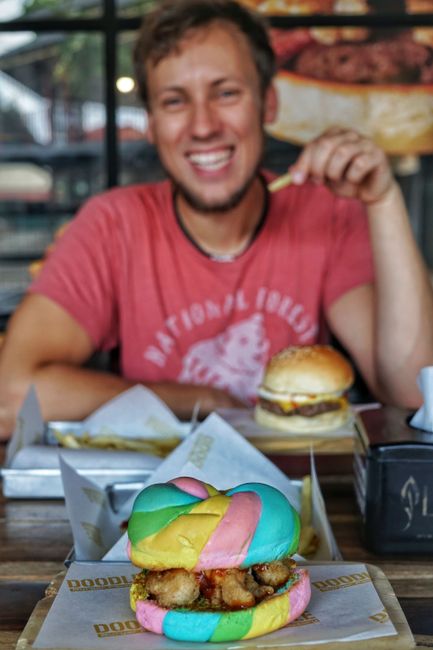
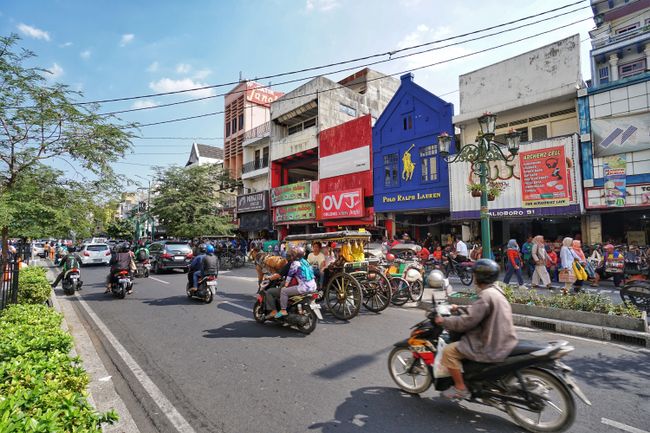
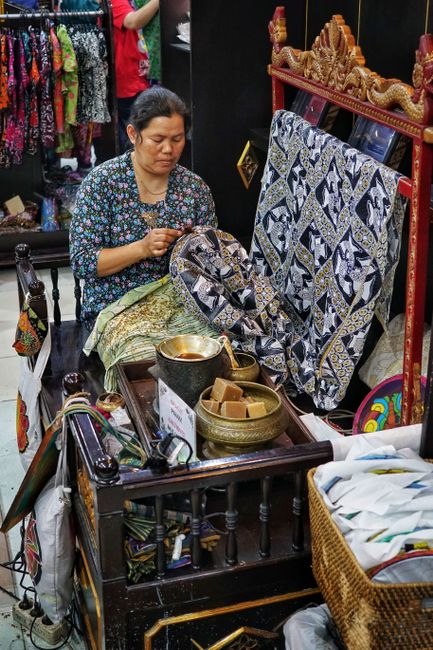
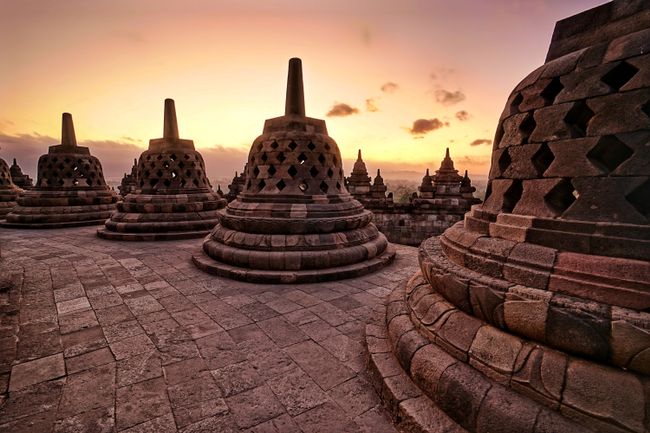
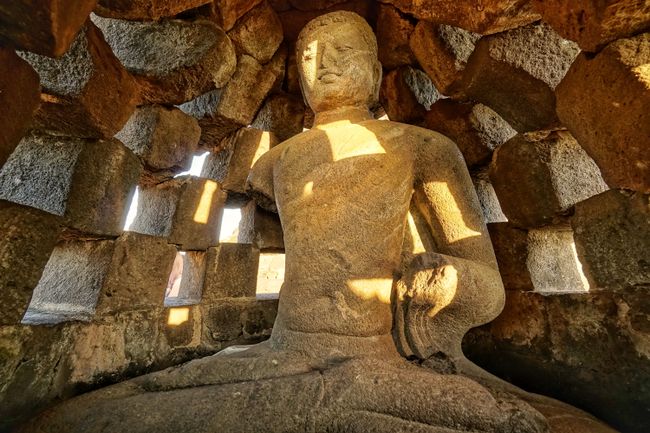
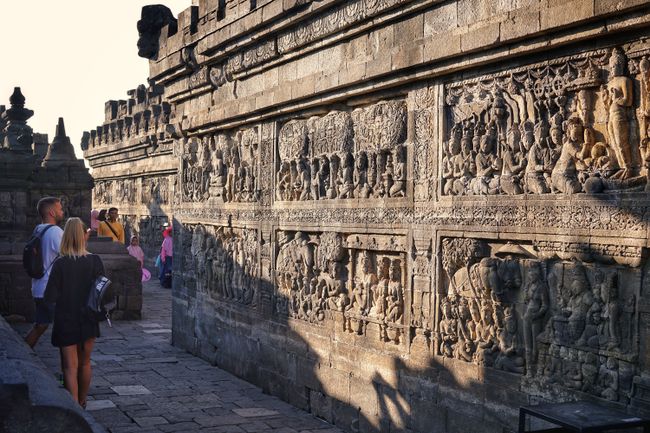
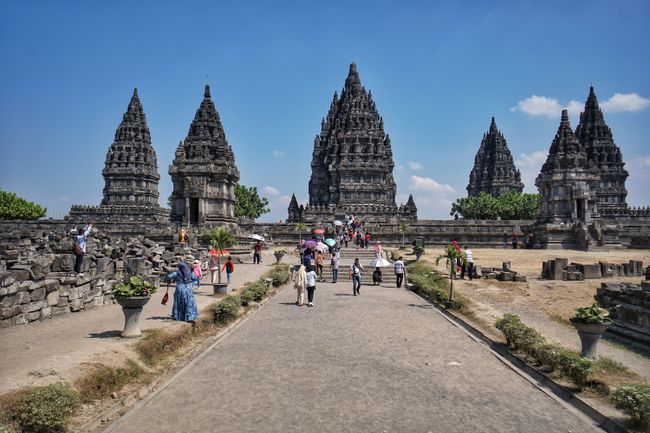
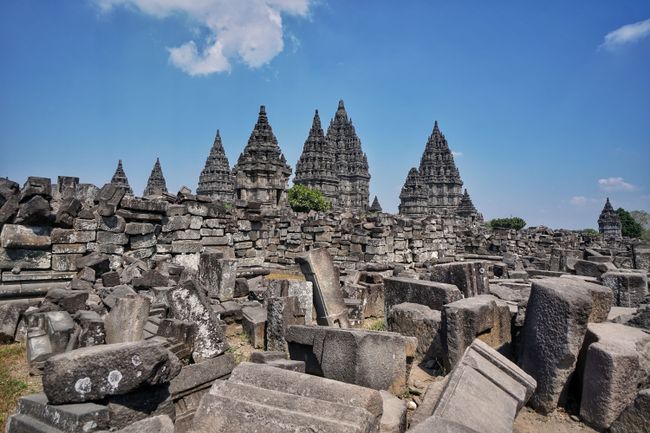
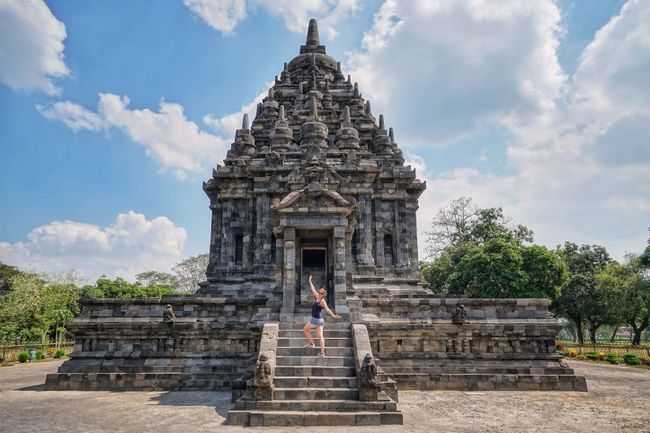
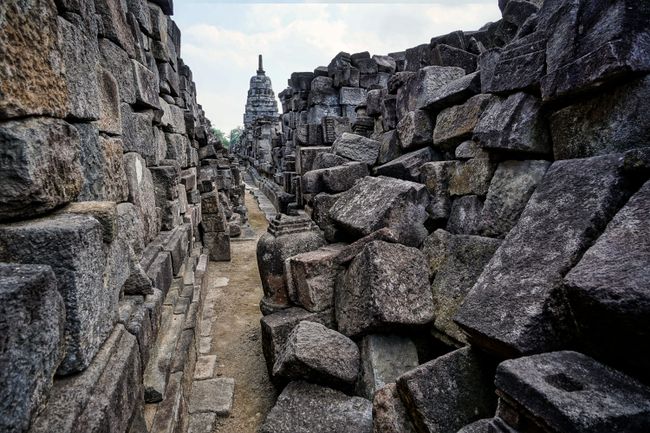
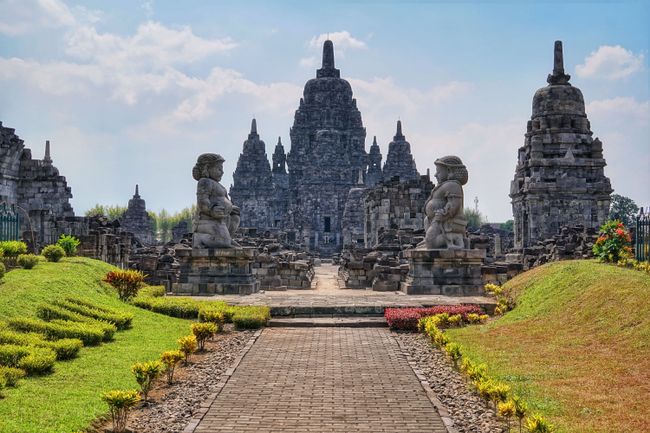
Բաժանորդագրվել տեղեկագրին
Next, we took a ferry (okay, let's admit it was more like a floating rust bucket) to Java, the most densely populated island in Indonesia with 130 million residents. Beforehand, we had to face some challenges: not many Western tourists come to Java, so hardly anyone spoke English and as white people, we naturally stood out. Additionally, Java is predominantly a Muslim island and we had to adapt to some customs and rules. For example, strictly speaking, unmarried couples are not allowed to sleep in the same room, so we had to carefully check the comments of other guests on the internet for any mention of this rule when booking accommodations. Furthermore, the local dress code is much stricter here, and as a woman wearing shorts and without a headscarf, Natalie naturally attracted a lot of stares, even though it was only unusual, not forbidden (but it was impossible to change in 35°C heat, otherwise she would have died of heatstroke). Additionally, Muslims pray 5 times a day. The problem is that the prayers are accompanied loudly over loudspeakers from the mosques, of which there are many (we fondly called it "gejalla"), even at 4 o'clock in the morning. So, sleeping through the night was not an option. We would like to emphasize at this point that we are not complaining about these religious rituals, we are just mentioning them because, as we have read, a Buddhist woman had to go to prison for 1.5 years because she had asked a mosque to turn down the volume of the loudspeakers. Prison is definitely not an option. So, somewhat tired and maybe a little intimidated by the local customs, we explored the island and we must say: it was fantastic!!!
The first highlight was right in our first night in Banyuwangi, the active volcano Ijen. In order to admire it in all its glory, we had to climb it in the middle of the night. So, together with our two new German friends who were staying in the same hostel, we were picked up by a dubious jeep at midnight. During the 1-hour drive, we almost suffered from carbon monoxide poisoning from the gasoline fumes inside the car, which actually prepared our lungs for the hike up the volcano. Once we arrived at the basecamp, we were finally equipped with gas masks and met our super nice guide, who started the ascent to the crater rim with us around 1:30 a.m. in complete darkness. Walking in the dark is truly an extraordinary experience. You can't see the destination, nor what surrounds you or how much distance you have already covered. Therefore, you are all the more motivated to simply reach the goal and almost fly up the mountain. After about 600 meters of altitude, we had made it and saw the light for the first time: the blazing blue fire in the crater of the volcano. This can only be seen in complete darkness, which is why we did this night hike. Now it became clear to us why we needed gas masks, because there was a large, smelly cloud of sulfur around us. To experience it even more intensively, we descended into the crater over a steep, rocky path, very close to the blue fire that is nourished by the sulfur coming out of the earth. You could hear it crackle and hiss and feel how the sulfur irritates your throat and eyes. It is even more shocking that about 250 miners earn their livelihood by extracting sulfur here in this absolutely inhospitable place. These poor people carry up to 100kg of sulfur from the inside of the crater to the basecamp about 5km away, without the help of an animal or a machine, four times a day. There, they receive the equivalent of 6 cents per kilogram of sulfur. It is hard to imagine that a human being, especially one as fragile as these undernourished miners, can lift such a heavy load or carry it several kilometers on their shoulders. Watching it makes you speechless and definitely makes you realize your own happiness in life, because with a heavy heart we understood that what is an adventure and fun for us represents a bitter, burdensome, and deadly everyday life for these people.
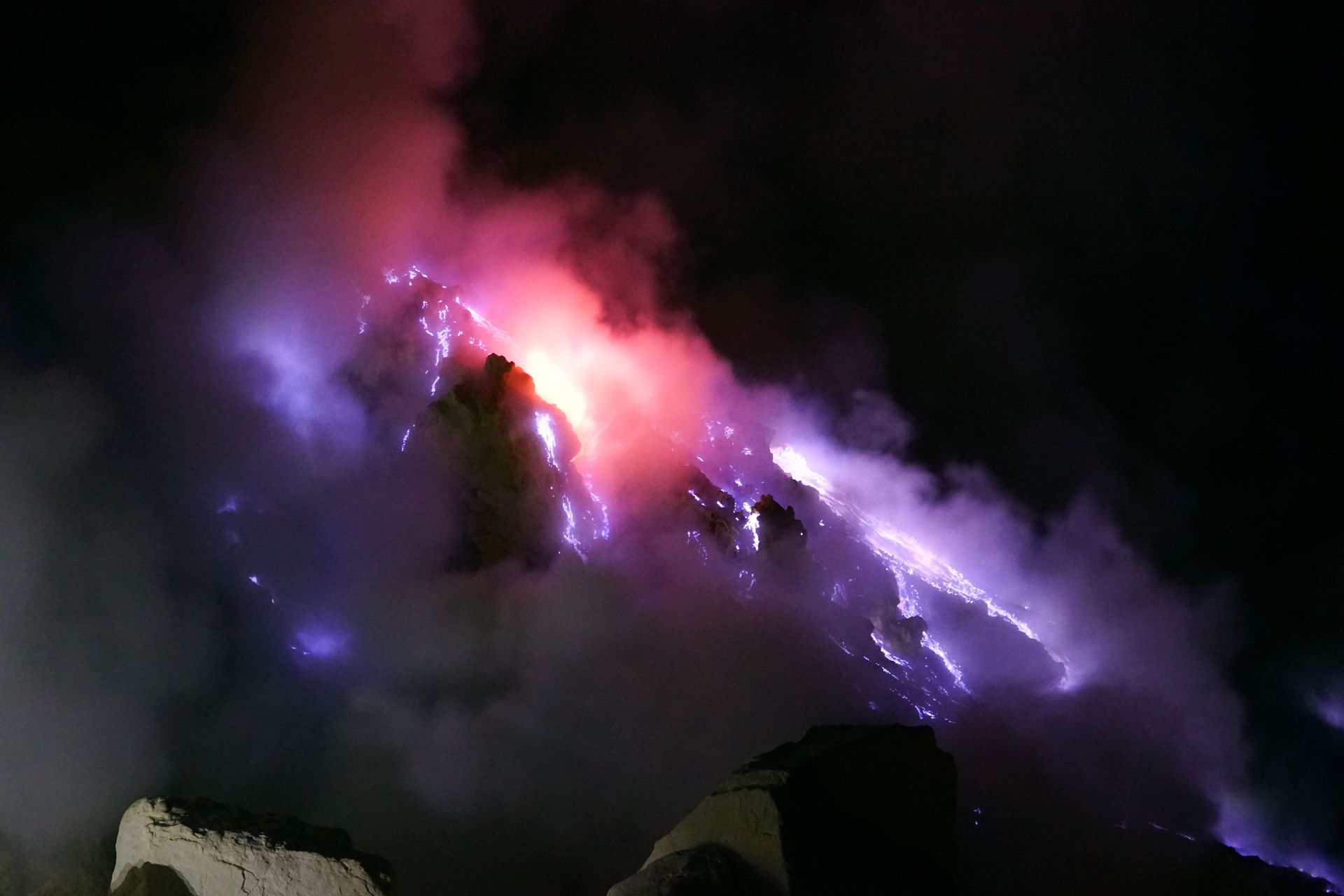

To lift our spirits, our guide took us on a small tour with him during the day after this spectacular but also sad experience. He took us to a coffee plantation and showed us how coffee grows and that the famous Luwak coffee, which is made from the digested and excreted coffee beans of a cat-like animal, can simply be collected from the ground here. Afterwards, we drank coffee and ate roasted coffee beans in a roastery. Natalie is still not a fan of coffee, but it was still interesting and simply part of Java.
We continued our journey through Java by train. The train system in Java is very well developed and planned, and the slightly higher class carriages are very spacious and luxurious. After our 4-hour train ride through rice fields and past volcanoes, we arrived in Probolinggo. There, we had to wait 6 hours for our bus to the Bromo Tengger Semeru National Park in the mountains, together with two Englishmen, because the bus would only leave when we had at least 6 passengers. Fortunately, after 6 hours, the required 2 passengers arrived (we have never been so grateful for French tourists) and we could finally start the 1-hour drive in the dark. What would we have done if the bus had stopped running? No idea.
However, the national park was definitely worth this little adventure on the way there. We could finally go hiking and enjoy the empty and quiet expanses of the area, especially since it is on average 20°C colder here than on the coast. The national park consists mainly of 3 volcanoes (Bromo, Tengger, and Semeru), all of which are active and emit smoke and ash. The small village at the national park, where we stayed, is located directly on the huge crater rim, where the smoking cone of Bromo and the green cone of Batok are located. Otherwise, the crater is a barren landscape covered with thick ash and surrounded by steep green hills.

During our hikes, we could look into the crater of Bromo and see its clouds of smoke billowing, trudge through the ash landscape and get ourselves really dirty, observe whirlwinds as they danced through the dust desert, and enjoy the view of all the surrounding volcanoes during the sunrise. This is how we imagined Java.


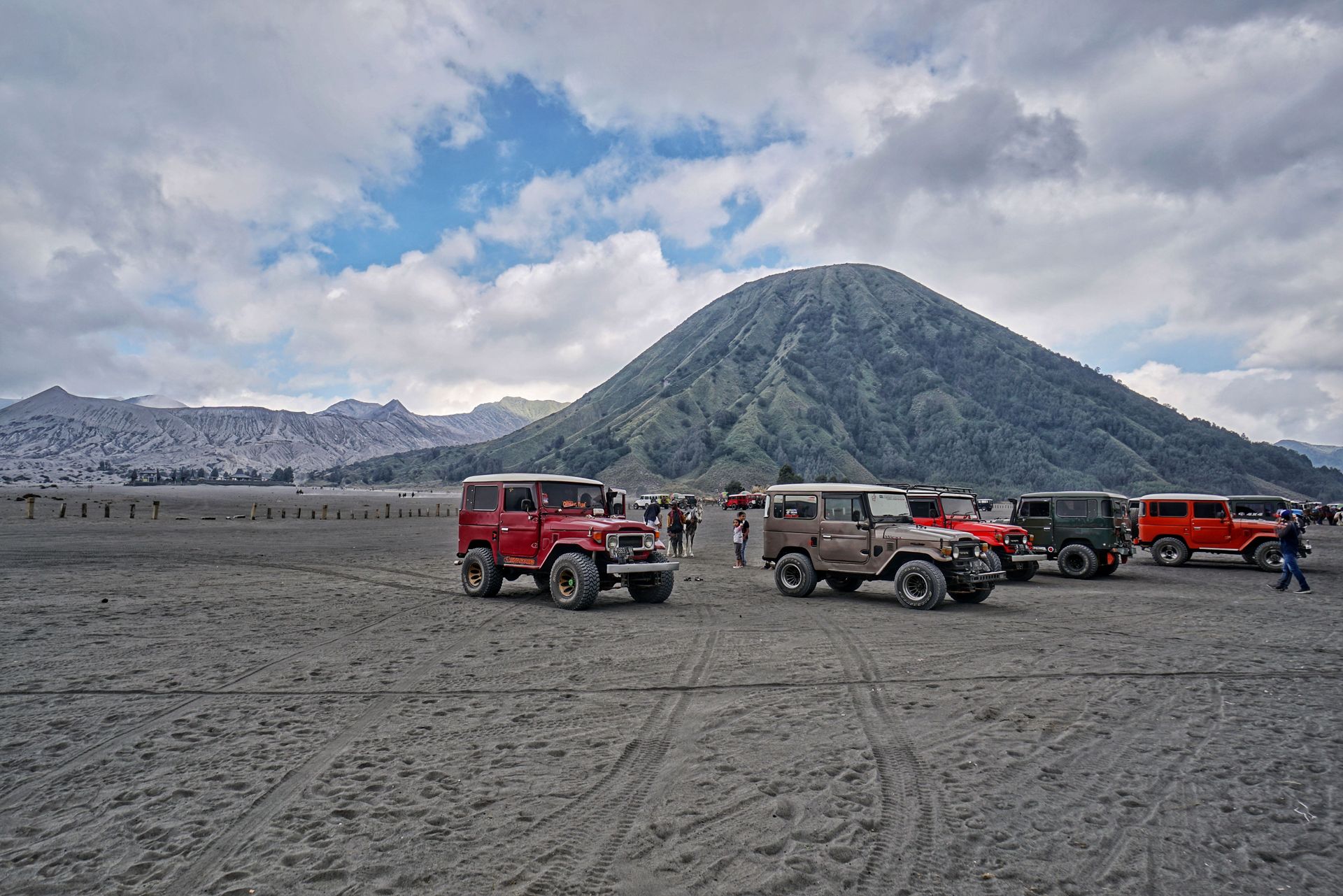
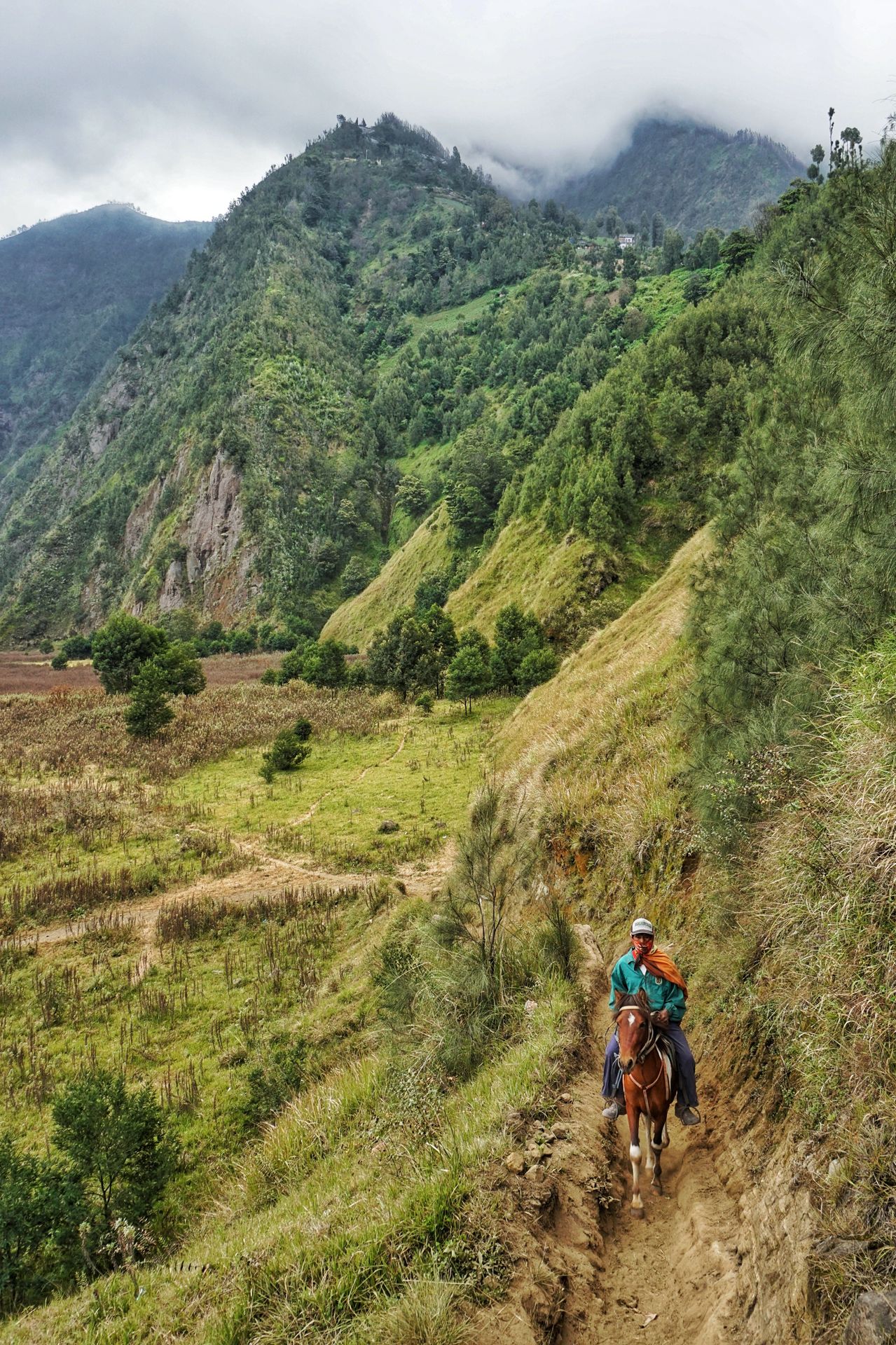
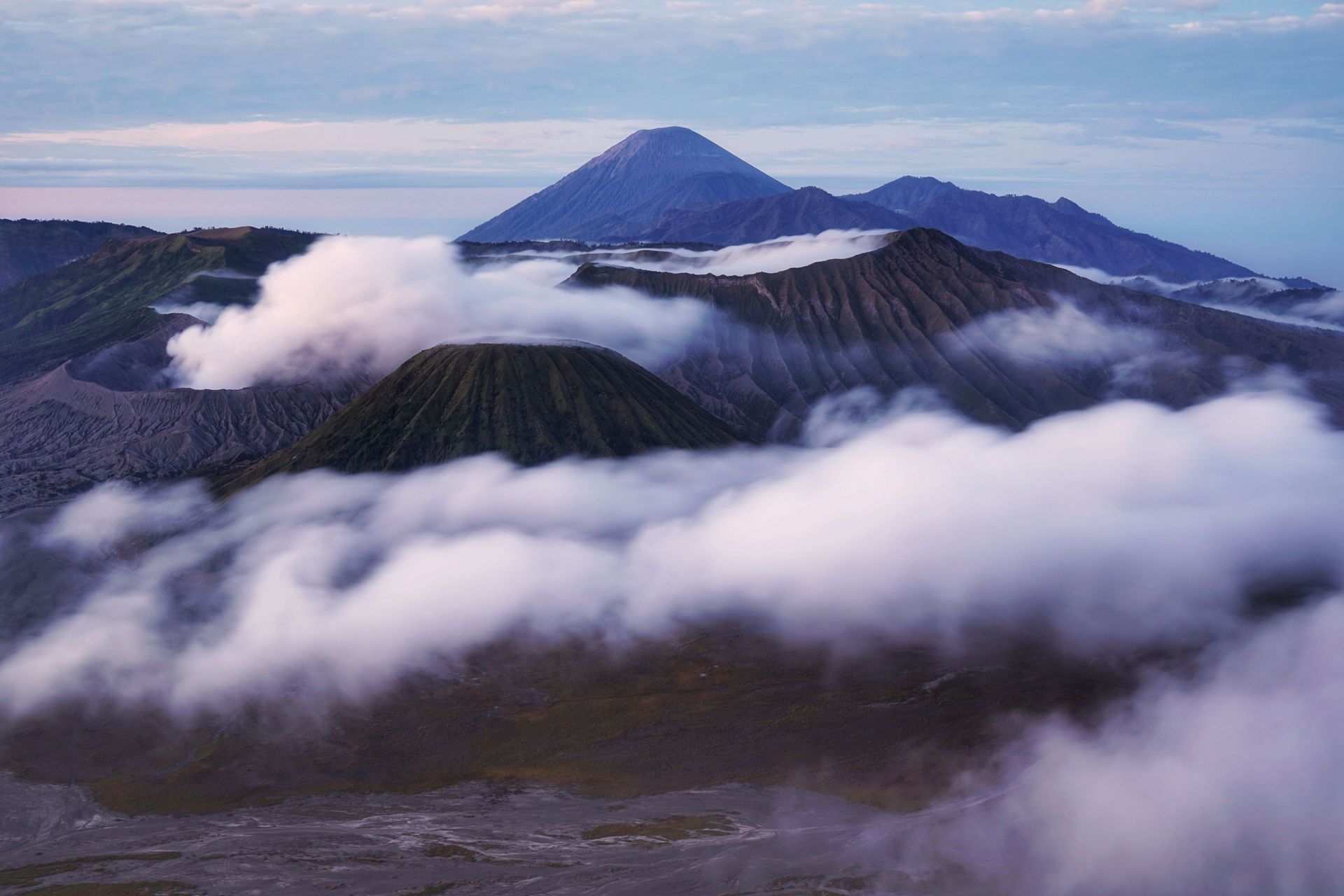

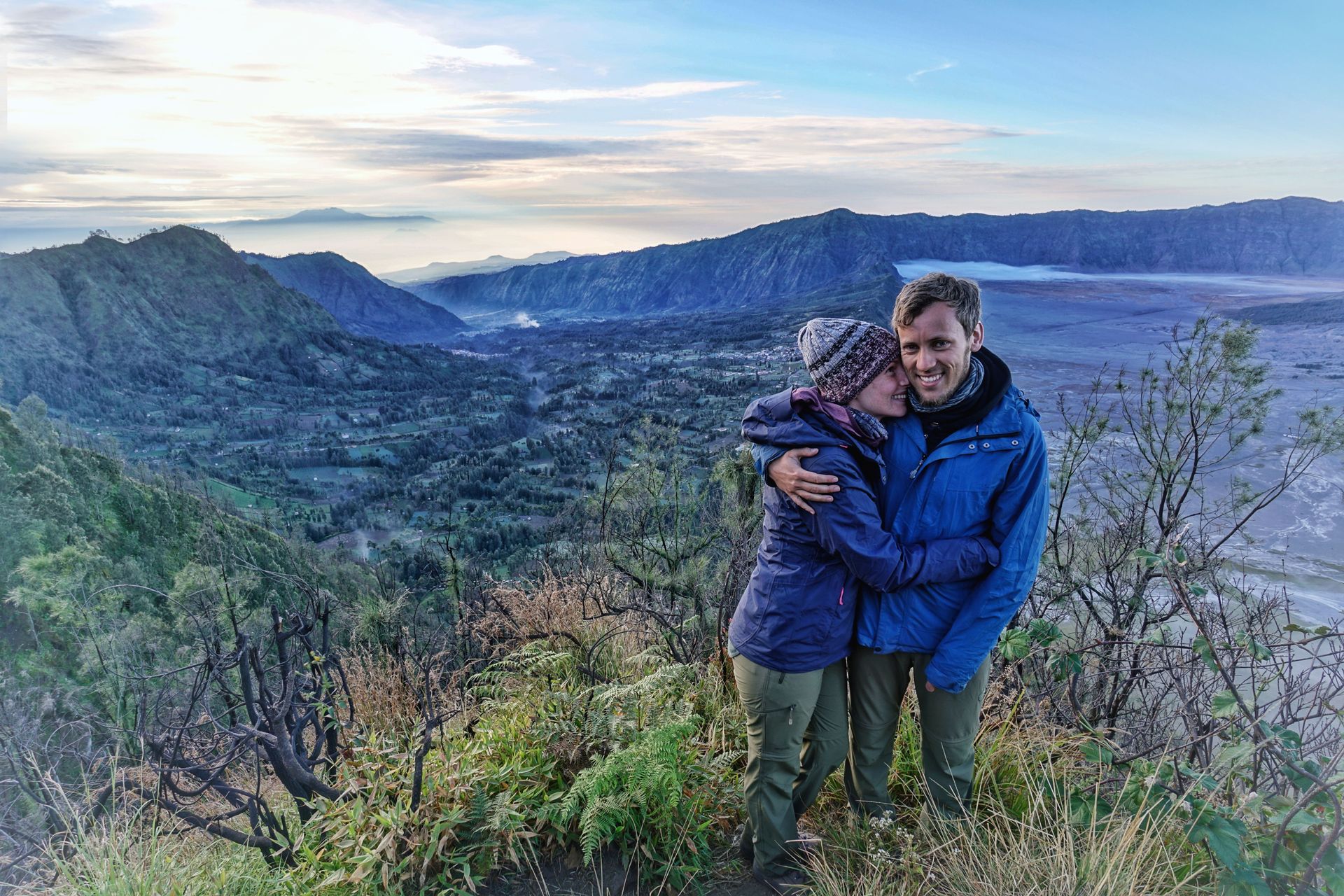
Since we wouldn't have been able to sleep anyway in the heat and with the loud prayers from our neighboring mosque, the four of us decided to take a little tour with our host during the day. He took us to a coffee plantation and showed us how coffee grows and that the famous Luwak coffee, which is made from the digested and excreted coffee beans of a cat-like animal, can simply be collected from the ground here. Afterwards, we drank coffee and ate roasted coffee beans in a roastery. Natalie is still not a fan of coffee, but it was still interesting and simply part of Java.
We continued our journey through Java by train. The train system in Java is very well developed and planned, and the slightly higher class carriages are very spacious and luxurious. After our 4-hour train ride through rice fields and past volcanoes, we arrived in Probolinggo. There, we had to wait 6 hours for our bus to the Bromo Tengger Semeru National Park in the mountains, together with two Englishmen, because the bus would only leave when we had at least 6 passengers. Fortunately, after 6 hours, the required 2 passengers arrived (we have never been so grateful for French tourists) and we could finally start the 1-hour drive in the dark. What would we have done if the bus had stopped running? No idea.
However, the national park was definitely worth this little adventure on the way there. We could finally go hiking and enjoy the empty and quiet expanses of the area, especially since it is on average 20°C colder here than on the coast. The national park consists mainly of 3 volcanoes (Bromo, Tengger, and Semeru), all of which are active and emit smoke and ash. The small village at the national park, where we stayed, is located directly on the huge crater rim, where the smoking cone of Bromo and the green cone of Batok are located. Otherwise, the crater is a barren landscape covered with thick ash and surrounded by steep green hills.

During our hikes, we could look into the crater of Bromo and see its clouds of smoke billowing, trudge through the ash landscape and get ourselves really dirty, observe whirlwinds as they danced through the dust desert, and enjoy the view of all the surrounding volcanoes during the sunrise. This is how we imagined Java.







To lift our spirits, our guide took us on a small tour with him during the day after this spectacular but also sad experience. He took us to a coffee plantation and showed us how coffee grows and that the famous Luwak coffee, which is made from the digested and excreted coffee beans of a cat-like animal, can simply be collected from the ground here. Afterwards, we drank coffee and ate roasted coffee beans in a roastery. Natalie is still not a fan of coffee, but it was still interesting and simply part of Java.
We continued our journey through Java by train. The train system in Java is very well developed and planned, and the slightly higher class carriages are very spacious and luxurious. After our 4-hour train ride through rice fields and past volcanoes, we arrived in Probolinggo. There, we had to wait 6 hours for our bus to the Bromo Tengger Semeru National Park in the mountains, together with two Englishmen, because the bus would only leave when we had at least 6 passengers. Fortunately, after 6 hours, the required 2 passengers arrived (we have never been so grateful for French tourists) and we could finally start the 1-hour drive in the dark. What would we have done if the bus had stopped running? No idea.
However, the national park was definitely worth this little adventure on the way there. We could finally go hiking and enjoy the empty and quiet expanses of the area, especially since it is on average 20°C colder here than on the coast. The national park consists mainly of 3 volcanoes (Bromo, Tengger, and Semeru), all of which are active and emit smoke and ash. The small village at the national park, where we stayed, is located directly on the huge crater rim, where the smoking cone of Bromo and the green cone of Batok are located. Otherwise, the crater is a barren landscape covered with thick ash and surrounded by steep green hills.

During our hikes, we could look into the crater of Bromo and see its clouds of smoke billowing, trudge through the ash landscape and get ourselves really dirty, observe whirlwinds as they danced through the dust desert, and enjoy the view of all the surrounding volcanoes during the sunrise. This is how we imagined Java.







We wouldn't have been able to sleep anyway in the heat and with the loud prayers from our neighboring mosque, so the four of us decided to take a little tour with our host during the day. He took us to a coffee plantation and showed us how coffee grows and that the famous Luwak coffee, which is made from the digested and excreted coffee beans of a cat-like animal, can simply be collected from the ground here. Afterwards, we drank coffee and ate roasted coffee beans in a roastery. Natalie is still not a fan of coffee, but it was still interesting and simply part of Java.
In Yogyakarta, our last destination in Java, we finally got to enjoy European cuisine again, because the city is not lacking in good restaurants. Well, Jan still wanted to eat local cuisine and got the receipt for it with accidentally ordered chicken feet.
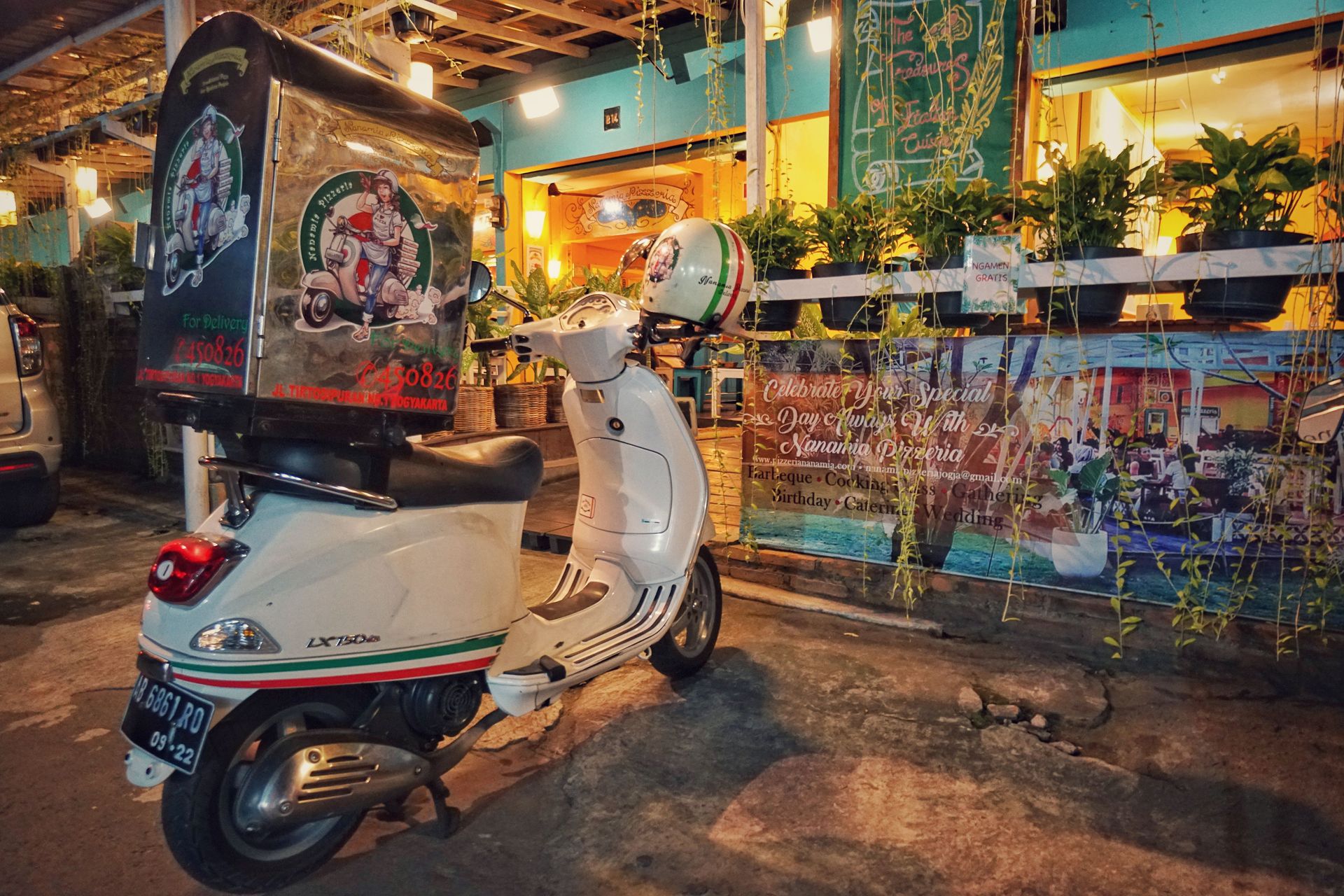
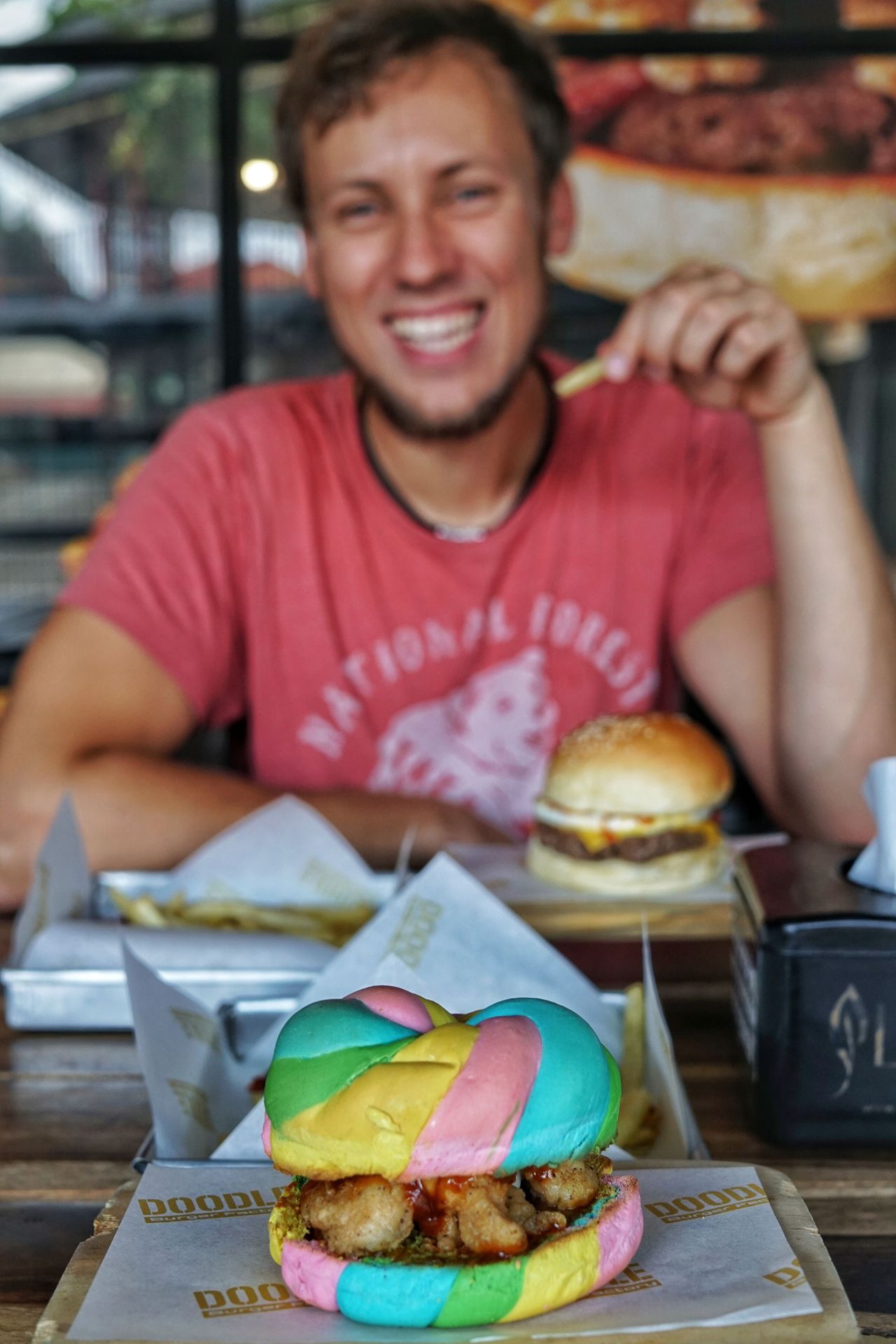
In addition, we ventured onto the very crowded and hectic Malioboro Street, where you can buy a lot of batik and other typical souvenirs (and of course, you are also pushed to do so), and we took a trip to the zoo, where we were the main attraction. Maybe we should have realized that a visit to the zoo is not necessarily a typical activity for Western tourists and that local tourists would treat us like zoo animals because we are rare birds to them. So, we had to spend more time taking pictures with the locals one after the other or hiding from very pushy individuals, rather than observing the animals ourselves. And now we know what it's like to live as a zoo animal.


The best parts of Yogyakarta, however, were our visits to two of the most famous and largest temples in the world. First, we went to the Buddhist temple Borobudur early in the morning (by early, we mean 3 o'clock in the morning) to experience the sunrise there, so we could explore and enjoy the temple before all the day trippers arrived. Borobudur is a pyramid-like temple from the 9th century, with its calling card being the bell-shaped "stupas" that contain Buddha figures. Due to its size, age, and unusual stupas, it is a UNESCO World Heritage Site and has been lovingly restored after many devastating earthquakes. Besides the thousands of Buddhas and figures carved into the walls, we were of course impressed by the huge bell structures against the red-orange-tinted sky, which made us pause. Here you can understand why Buddhism is such a calm and peaceful religion because you can truly find peace at this place.
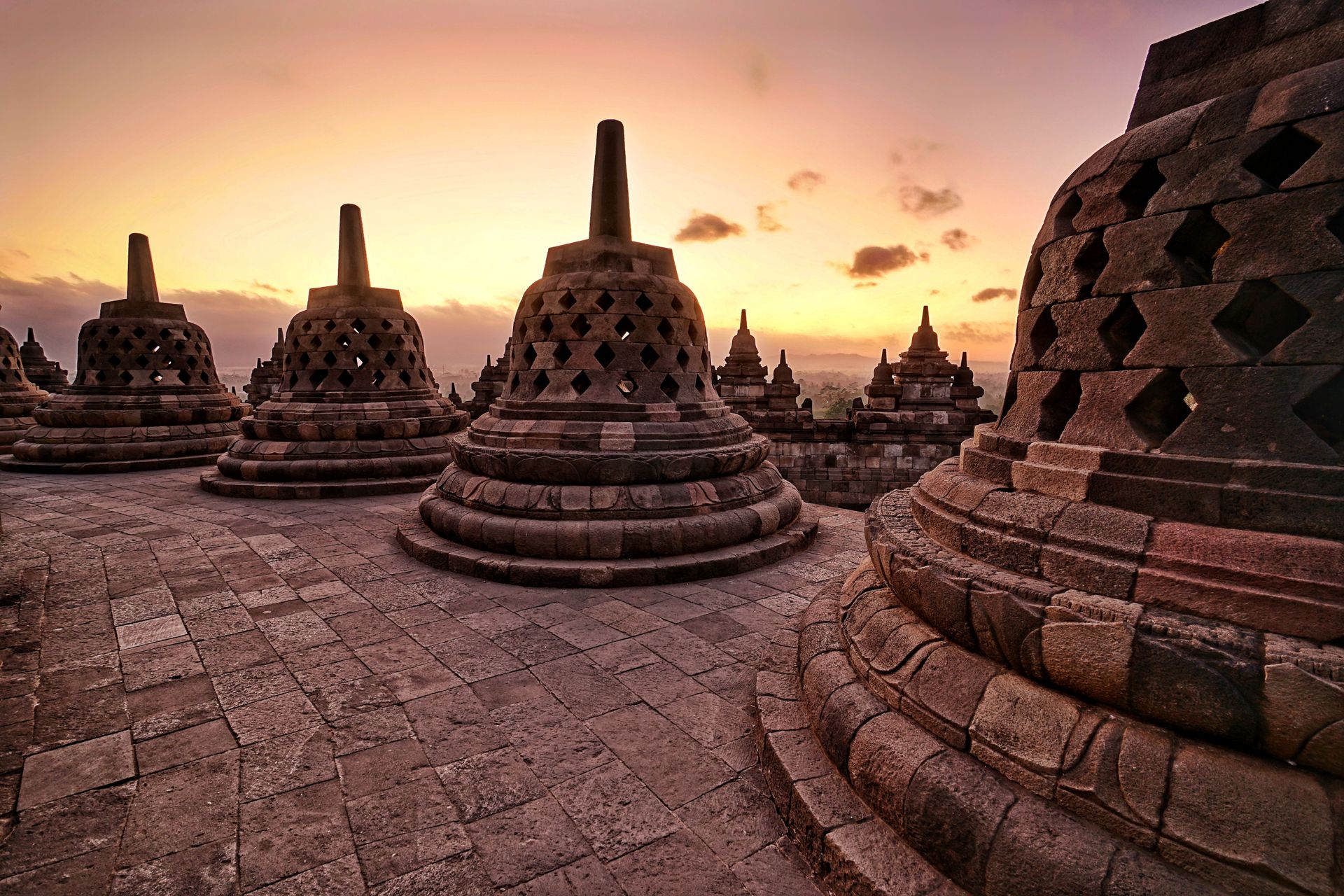
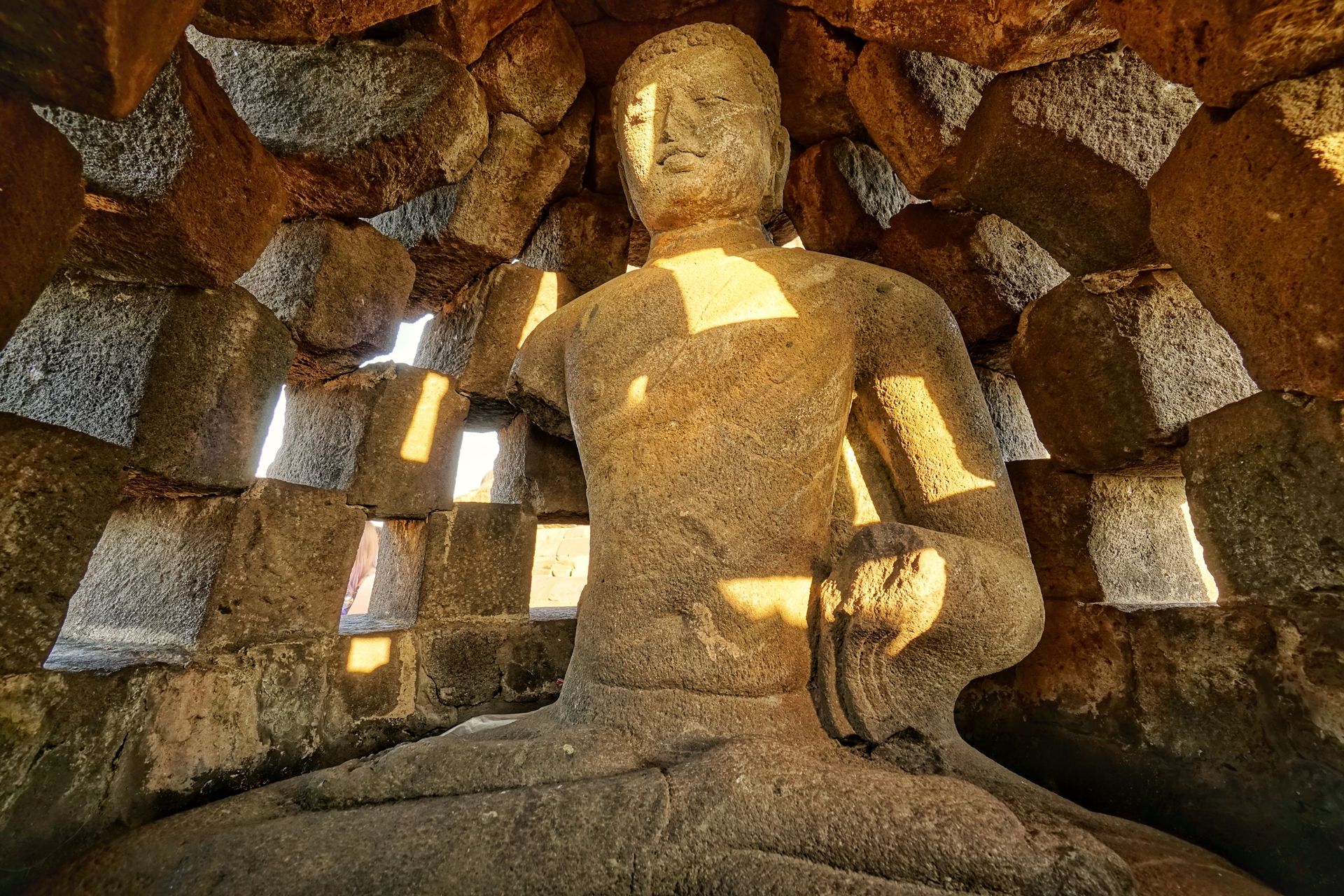

We visited the second famous temple complex from the same century in daylight. The Prambanan Temple is the largest and only Hindu temple in the complex. The remaining smaller but equally impressive temples are Buddhist. They are all heavily marked by earthquakes and heavily decayed. Restoration is extremely time-consuming and complicated because many stones are missing or cannot be assigned to their original location. Wandering through these rubble fields like a labyrinth and catching glimpses of the still-standing towers truly makes you feel like a child again. You completely forget about the crowds because apparently, we were the only ones who enjoyed exploring the temples. Everyone else posed for photos and then fled to the shade because of the heat.
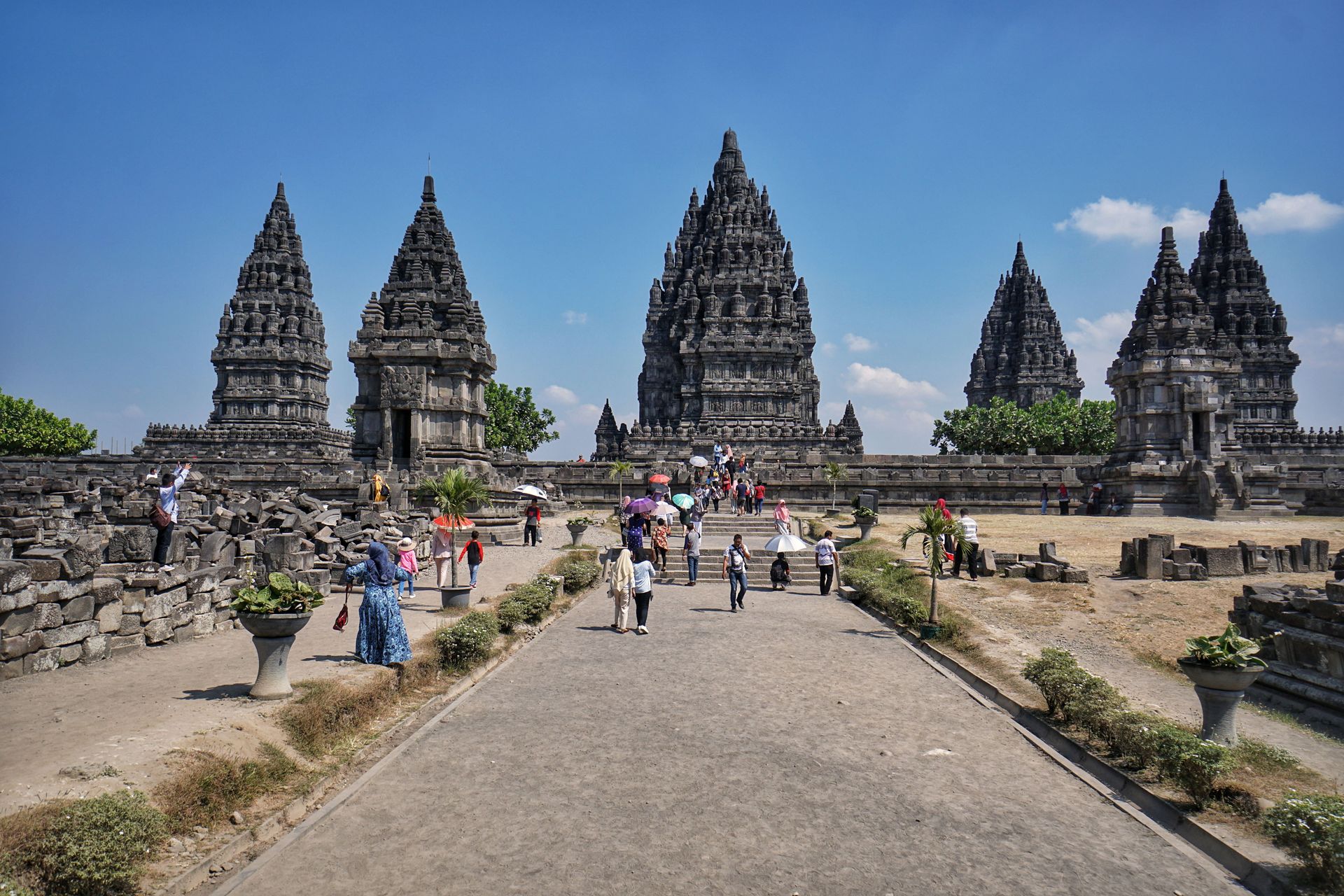

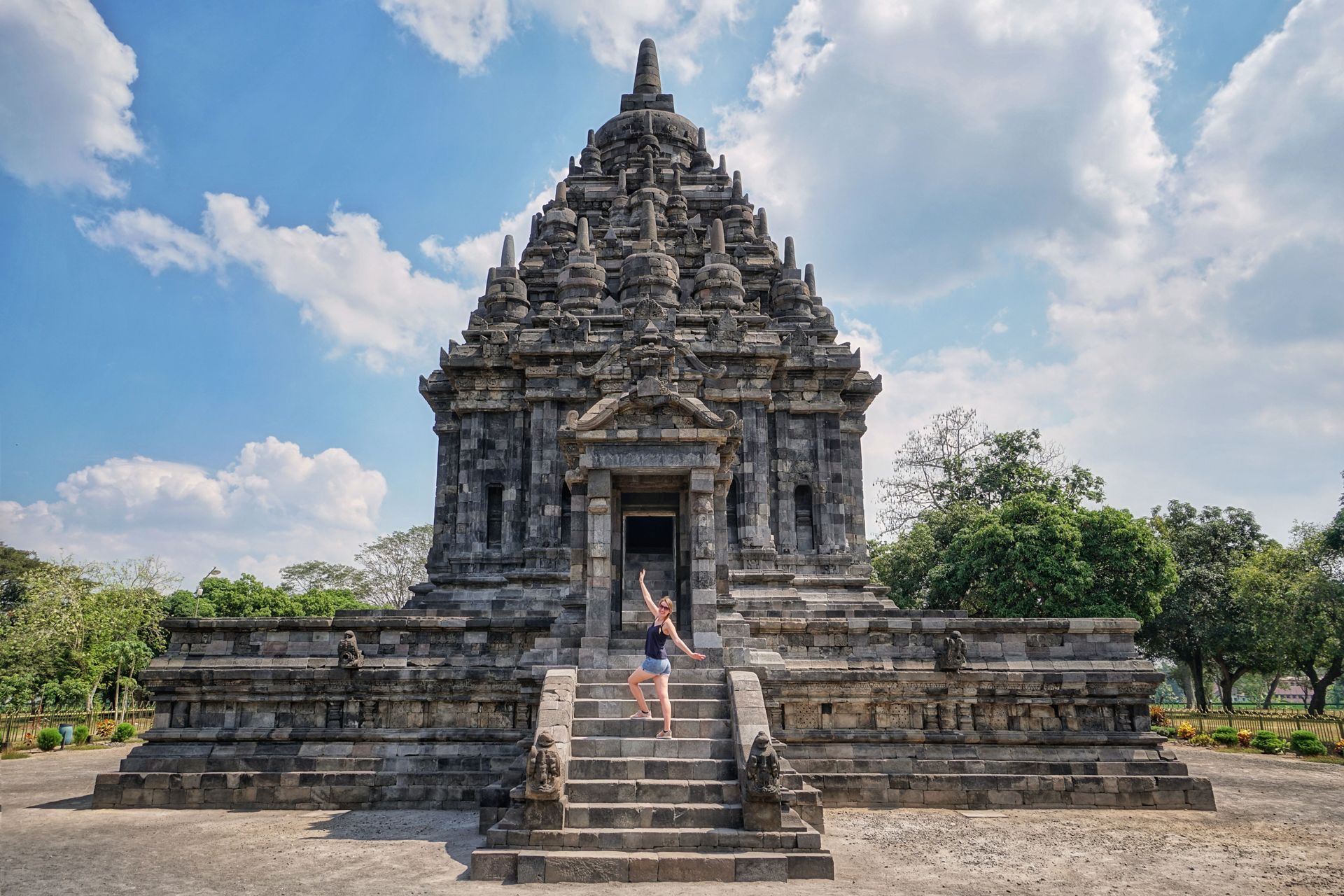
We liked the Sewu Temple the best because we were almost alone there and could explore every corner in peace. Why were we alone? Because the temple is 800m away from the famous Prambanan Temple and everyone else was too lazy to make that journey. We were lucky!
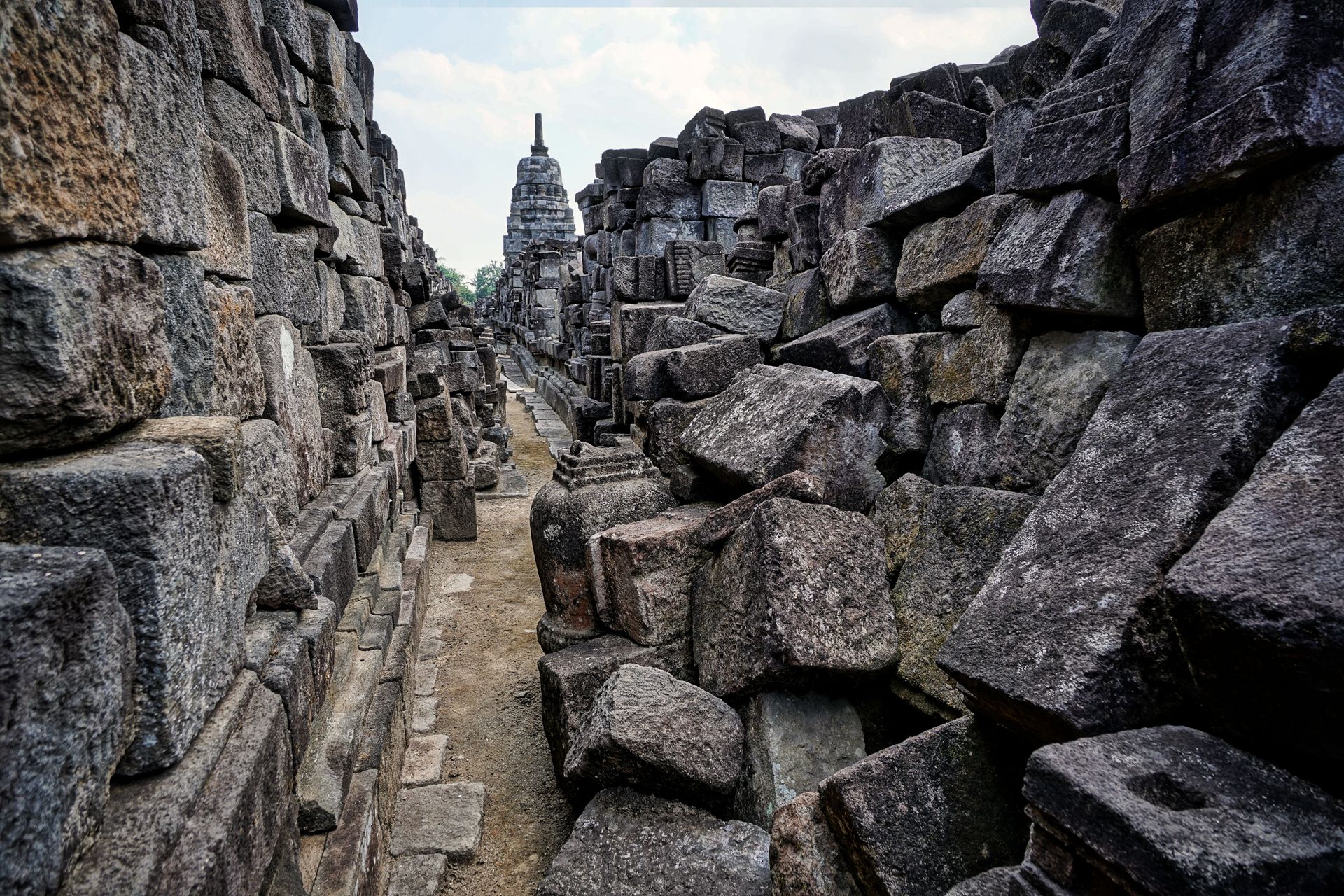
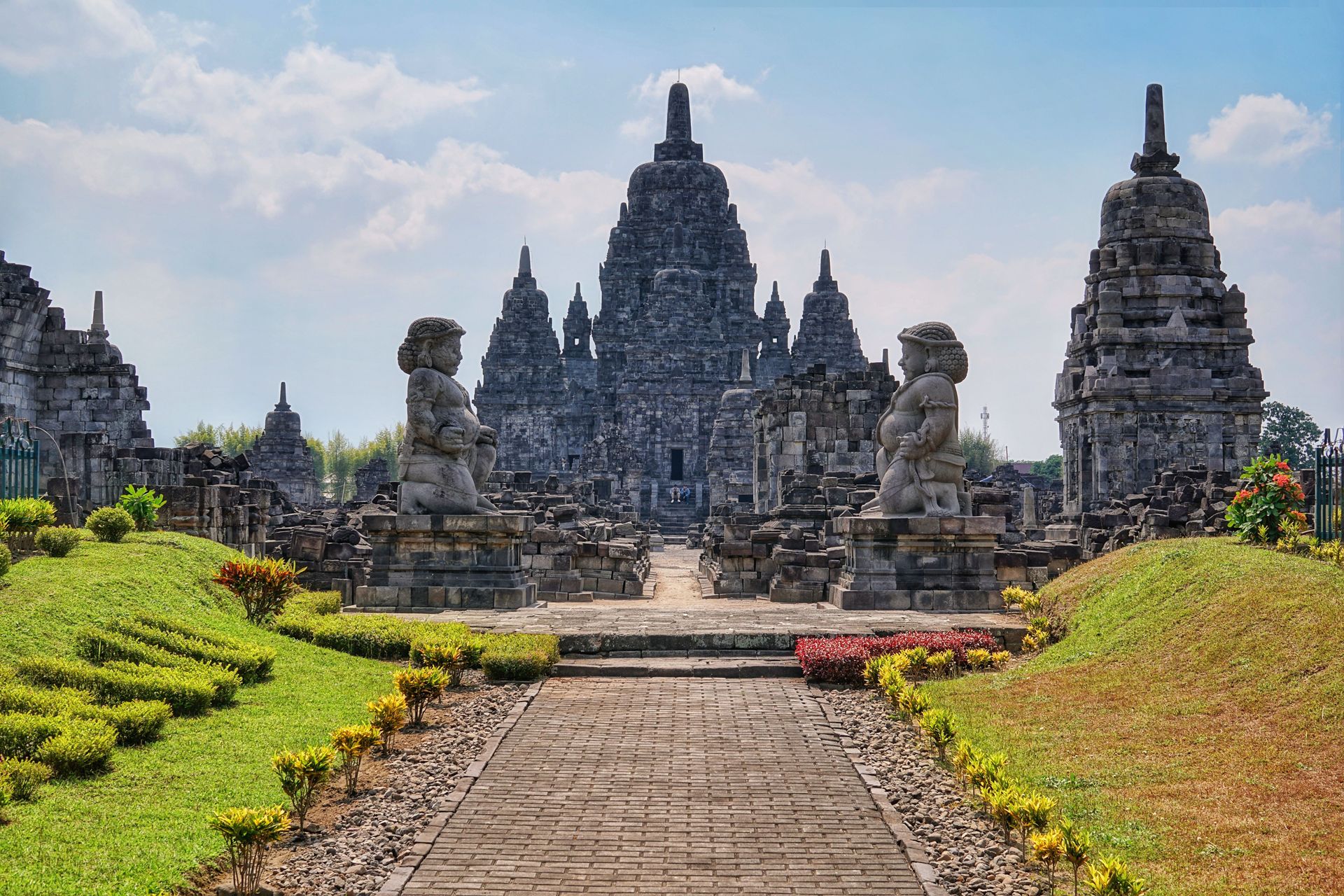
Song of hiking Java's volcanoes: Young Volcanoes - Fall Out Boy
Բաժանորդագրվել տեղեկագրին
Պատասխանել
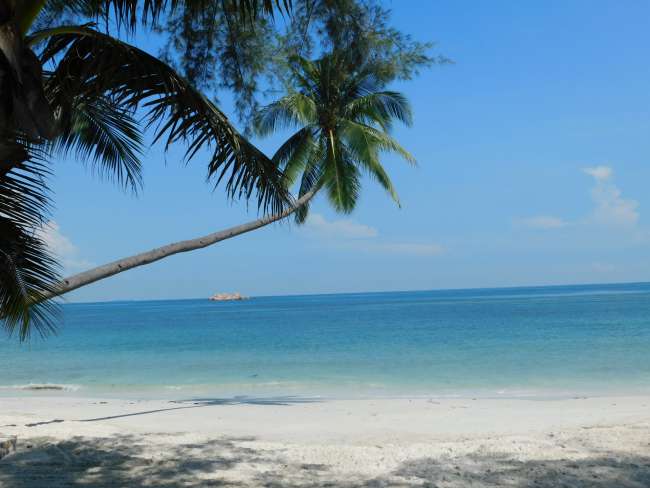
Ճանապարհորդական հաշվետվություններ Ինդոնեզիա
